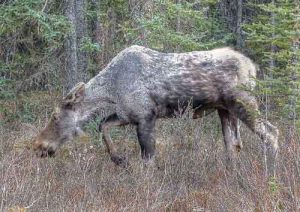
(Juneau) –Early in the morning of June 2, ADF&G Nome area staff received several reports about a moose that was in and around the community of Teller and acting aggressively towards people. The moose was unbalanced, stumbling, drooling profusely, and had bare patches of skin. ADF&G staff in Nome consulted with ADF&G wildlife veterinarian Dr. Kimberlee Beckmen and dispatched the animal that afternoon due to its aggressive behavior and signs suggestive of rabies disease. ADF&G staff collected samples from the moose and sent them for testing. ADF&G staff also coordinated with the City of Teller and burned the carcass.
Rabies virus in the brain was detected on June 5 by the Alaska State Virology Laboratory. On June 6, the Centers for Disease Control and Prevention further confirmed the virus was an Arctic Fox rabies variant. This is the same variant circulating in red foxes during the outbreak in the Nome/Seward Peninsula and North Slope arctic foxes this past winter, suggesting the moose contracted the virus from a fox.
This is the first recorded confirmation of rabies in a moose in Alaska. Rabies diagnoses in moose are rare, but there have been moose diagnosed with rabies in South Dakota, Minnesota, Canada and Russia. In Alaska, only those moose with neurologic signs are screened for rabies (along with other potential causes of brain inflammation, such as Chronic Wasting Disease, parasite migrations, or toxicities).
Due to this new case, ADF&G plans to increase rabies surveillance by testing all brain samples from wild mammals found dead or euthanized from regions with enzootic fox rabies, including Western Alaska, when feasible. Members of the public can help by calling ADF&G if they find a dead mammal or see a mammal with any signs of rabies (excessive salivation, abnormal / aggressive behavior, bite marks, etc.) Pictures or videos of the animal are helpful, but it is important to not come into contact with a potentially rabid animal or carcass.
Due to the largely solitary nature of moose, it is very unlikely that any rabies outbreak will occur in the moose population, but isolated cases such as this one occur rarely. Moose that are killed by hunters on the Seward Peninsula that show normal behavior and no signs of any abnormality or illness should still be considered safe to consume. Precautions when butchering moose or other mammals for human consumption would include using rubber or latex gloves. When done handling game wash hands thoroughly with soap or disinfectant, and disinfect knives, equipment and surfaces that were in contact with game. You should not eat, drink or smoke while handing game, and should cook the game to an internal temperature of 165 degrees F.
Vaccinating dogs and cats against rabies continues to be the most important way to prevent rabies disease in people. Likewise, preventing pets from interacting with foxes or other wildlife, and not leaving garbage or other attractants accessible to foxes and other wildlife, remain important.
If a person is bitten by a wild animal or a pet that may have been exposed to rabies, immediately wash the wound with soap and water and seek medical attention. Contact the Alaska Section of Epidemiology for more information: 907-269-8000.
Please report wildlife found dead or acting abnormally to the nearest ADF&G area office as soon as possible so staff may respond appropriately.
Rabies resources:
• ADF&G Rabies webpage: http://www.adfg.alaska.gov/index.cfm?adfg=disease.general1
• Alaska DOH/Section of Epidemiology Rabies webpage: https://health.alaska.gov/dph/Epi/id/Pages/rabies/default.aspx
